7 Key Differences Between Ceramic Coating and Graphene Ceramic Coating [2024 Guide for US Drivers]
20 September 2024
Summary of Graphene vs Ceramic Coatings for US Drivers
For US drivers looking to protect their vehicles, understanding the differences between graphene and ceramic coatings is crucial. Graphene coatings offer superior durability, being thinner yet stronger than ceramic coatings, and are less prone to water spotting and etching. This makes them ideal for hot climates and regions with harsh weather conditions.
Additionally, graphene dissipates heat better and provides a longer-lasting hydrophobic effect, ensuring easier maintenance and protection against dirt, oil, and environmental damage.
While ceramic coatings are more widely available, graphene’s enhanced performance makes it a valuable upgrade for long-term vehicle care.
Price Range: Graphene vs Ceramic Coating
In the US, graphene coatings, a newer innovation in the car care industry, generally cost between $70 and $100 for a 30ml bottle. This amount is typically enough to coat a mid-sized vehicle. On the other hand, ceramic coatings are slightly more affordable, ranging from $50 to $90 for the same 30ml quantity. The price difference reflects the enhanced durability and performance of graphene coatings, which can last 5-10 years, compared to ceramic coatings that typically last 2-5 years.
Professional application of ceramic coatings, which involves additional labor, can cost upwards of $1,000, with luxury services reaching as high as $2,500 depending on vehicle size and condition. In contrast, graphene coatings, though newer and more advanced, follow a similar pricing structure but might offer superior resistance to environmental damage, heat, and water spotting.
Significance of Knowing the Difference between Graphene Coating and Ceramic Coating
US drivers should be aware of the different types of protective coatings available for their cars, as choosing the right one can significantly impact the vehicle’s longevity, appearance, and ease of maintenance.
With varying weather conditions across the country, from intense sun to heavy rain and snow, the right coating can offer enhanced protection against environmental factors like UV rays, road salts, and water spots.
This knowledge helps US drivers make informed decisions that align with their specific driving environments and maintenance preferences, ensuring their cars remain in excellent condition for years to come. Additionally, understanding these options allows for better long-term cost savings by reducing the need for frequent detailing and repainting.
In short, both ceramic coatings and graphene ceramic coatings are advanced technologies developed to protect surfaces, but they have distinct properties, formulations, and applications. Below is a detailed comparison on the science of ceramic coatings and graphene ceramic coatings.
1. Graphene VS Ceramic Coating: Composition and Structure
- Ceramic Coating: Ceramic coatings are typically composed of silicone-based polymers such as polydimethylsiloxanes (PDMS), combined with resins, solvents, and additives. PDMS forms the backbone of the ceramic coating, giving it the characteristic hardness, gloss, and hydrophobic properties. The curing process involves cross-linking agents that strengthen the coating.
- Graphene Ceramic Coating: Graphene coatings are made from a single layer of carbon atoms arranged in a honeycomb structure. They can also exist as graphene oxide (GO) or reduced graphene oxide (RGO), which have functional groups that can enhance their chemical reactivity. Graphene is often incorporated into resin systems, and its high strength and enhanced abilities add advanced properties to the ceramic coating.
Key Difference:
Ceramic coatings rely on polymeric materials for protection and hydrophobicity, while graphene coatings focus on carbon nanomaterial for additional strength and enhanced mechanical properties.
2. Graphene VS Ceramic Coating: Hardness and Durability
- Ceramic Coating: Ceramic coatings are known for their hardness, with products like IGL’s ecocoat KENZO achieving up to a 10H rating on the pencil hardness scale. The hardness results from cross linking within the PDMS structure, which forms a rigid protective layer. Ceramic coatings are also designed to resist wear, chemical attacks, and UV degradation, providing long-lasting protection.
- Graphene Ceramic Coating: Graphene coatings are recognized for their exceptional strength—graphene itself is known as one of the strongest materials in the world. While still in development, graphene coatings enhance durability through improved mechanical properties such as corrosion resistance and anti-static capabilities. Graphene also provides resistance to environmental factors like UV rays, much like ceramic coatings.
Key Difference:
While both coatings offer durability and hardness, graphene’s inherent strength provides a superior level of mechanical resistance, making it more robust under physical stress. Ceramic coatings, however, have been more widely used and tested in terms of surface hardness.
3. Graphene VS Ceramic Coating: Hydrophobicity
- Ceramic Coating: Ceramic coatings form highly hydrophobic surfaces due to the orientation of methyl groups during the curing process. These coatings can achieve water contact angles between 91° and 120°, repelling water and preventing contaminants from sticking to the surface. The hydrophobic effect also makes surfaces easier to clean.
- Graphene Ceramic Coating: Graphene coatings are also hydrophobic, particularly when functionalized with additives like graphene oxide. However, graphene’s hydrophobicity is still being optimized. IGL Coatings has made progress in improving the water contact angle by increasing the concentration of graphene oxide in water-borne coatings, though they have not yet reached the desired hydrophobic levels of ceramic coatings.
Key Difference:
Ceramic coatings currently have more established and tested hydrophobic properties, while graphene coatings are still in development to achieve similar or higher water repellency.
4. Graphene VS Ceramic Coating: Chemical and Corrosion Resistance
- Ceramic Coating: Ceramic coatings provide excellent chemical resistance due to their crosslinked polymeric structure. They can withstand exposure to acids, solvents, and petroleum products. Additionally, ceramic coatings protect surfaces from corrosion and UV degradation, which is why they are widely used in automotive and architectural applications.
- Graphene Ceramic Coating: Graphene, being highly inert and chemically stable, offers impressive resistance to corrosion and chemical attacks. In studies, graphene-based coatings on metal surfaces significantly reduced corrosion, especially in salt environments. The ability of graphene to act as a barrier against oxidation and environmental degradation is one of its key advantages.
Key Difference:
Graphene coatings are more effective in providing corrosion resistance, especially in harsh environments, due to graphene’s exceptional chemical stability. Ceramic coatings, while also chemically resistant, have been primarily developed for surface protection rather than extreme corrosion prevention.
5. Graphene VS Ceramic Coating : Application and Formulation
- Ceramic Coating: Ceramic coatings are typically available in single-component (1-K) or dual-component (2-K) systems. The single-component formulations are easier to apply but may have a longer pot-life, whereas the dual-component systems require mixing before application and offer better performance in terms of hardness and durability.
- Graphene Ceramic Coating: Graphene coatings are still in development, particularly in water-borne formulations. The challenge lies in creating a transparent and effective protective layer without relying on solvent-borne binders, which can release harmful VOCs. IGL Coatings has focused on water-borne systems to avoid health and environmental risks, though these coatings are more complex to formulate and apply.
Key Difference:
Ceramic coatings have more mature and standardized application methods, while graphene coatings are advancing in formulation, especially in developing environmentally friendly water-borne systems.
6. Graphene VS Ceramic Coating : Environmental Impact and Safety
- Ceramic Coating: Traditional ceramic coatings, especially solvent-borne ones, can emit VOCs during curing, although IGL Coatings has formulated versions with low or zero VOCs to minimize emissions. These coatings are generally safe for users once fully cured.
- Graphene Ceramic Coating: Graphene coatings, particularly those being developed by IGL Coatings, focus on water-borne formulations to eliminate the risks associated with VOC emissions. This commitment to environmental and user safety makes graphene coatings a more sustainable option.
Key Difference:
Graphene coatings represent a more eco-friendly approach, especially when compared to traditional solvent-borne ceramic coatings, which may emit VOCs during the curing process.
7. Graphene VS Ceramic Coating : Industry Applications
- Ceramic Coating: Ceramic coatings are widely used in industries such as automotive, marine, and architecture. They are particularly valued for their ability to protect painted surfaces from UV damage, chemical exposure, and environmental wear, while also providing an easy-to-clean finish.
- Graphene Ceramic Coating: Graphene coatings, due to their superior mechanical properties, are being explored for use in industries where corrosion resistance, durability, and environmental protection are critical. While not yet as widely implemented as ceramic coatings, graphene is showing great potential in cutting-edge applications, including electronics and energy.
Key Difference:
Ceramic coatings are well-established in several industries, whereas graphene coatings are emerging with potential in highly specialized areas like anti-corrosion and protective barriers.
Final Thoughts for US Drivers
While both ceramic and graphene ceramic coatings offer advanced protection and share some similar properties, they differ significantly in terms of their composition, hydrophobicity, durability, environmental impact, and application areas. Ceramic coatings are more established in the market, offering strong hardness and hydrophobicity, especially in automotive and architectural industries.
On the other hand, graphene coatings, with their cutting-edge technology, hold immense promise for future applications, particularly in enhancing corrosion resistance and developing more sustainable, water-borne protective solutions.
Guidance for Choosing Between Ceramic Coating and Graphene Ceramic Coating in US
When deciding between ceramic coatings and graphene ceramic coatings, several key factors need to be considered. Below is a guide to help you determine which coating is best suited for your specific needs:
1. Surface Protection Needs:
- Ceramic Coating:
If your primary goal is to protect surfaces from general wear, UV damage, chemical exposure, and environmental contaminants, ceramic coatings are a proven choice. They provide excellent hydrophobicity, high gloss, and strong resistance to everyday wear and tear, making them ideal for automotive, marine, and architectural applications. Choose ceramic coatings if you need a durable, long-lasting protective layer with a high gloss finish. - Graphene Ceramic Coating:
If you need superior corrosion resistance, particularly in harsh environments like marine or industrial settings, graphene coatings may be the better option. Graphene’s incredible mechanical properties make it highly effective in preventing corrosion and providing enhanced protection in extreme conditions. If your surface is exposed to moisture, salt, or chemical agents that can lead to corrosion, graphene is likely the superior choice.
2. Desired Durability and Hardness:
- Ceramic Coating:
For surfaces that require a hard, scratch-resistant finish, ceramic coatings offer excellent durability, with hardness ratings as high as 10H on the pencil scale. This makes ceramic coatings well-suited for applications where surface integrity and appearance are critical, such as automotive paint protection and high-traffic areas. - Graphene Ceramic Coating:
Graphene coatings, while still being refined, promise enhanced mechanical durability. They are ideal if your surface requires protection from physical stress, impacts, or wear over time. Consider graphene if durability is your top priority and the surface will endure extreme mechanical strain.
3. Hydrophobicity and Ease of Cleaning:
- Ceramic Coating:
If you are looking for a coating with superior hydrophobic properties that make surfaces easy to clean and resistant to water, ceramic coatings offer well-established water repellency with contact angles up to 120°. They prevent contaminants like dirt, bird droppings, and water spots from adhering to the surface, making maintenance easier. - Graphene Ceramic Coating:
Although graphene coatings are still being developed for maximum hydrophobicity, they show promise in this area. If hydrophobicity is a secondary concern and your primary goal is to protect against corrosion or mechanical wear, graphene may still be a suitable option. However, if immediate and strong hydrophobicity is essential, ceramic coatings may be a better fit.
4. Environmental and Health Considerations:
- Ceramic Coating:
If you are concerned about the environmental impact and VOC emissions during application, check whether the ceramic coating you are considering is low- or zero-VOC. Many ceramic coatings in the market, especially solvent-borne systems, can release harmful VOCs. However, brands like IGL offer eco-friendly options that reduce or eliminate these emissions. - Graphene Ceramic Coating:
For those prioritizing sustainability, graphene coatings formulated with water-borne systems are a more eco-friendly choice. They avoid the use of harmful solvents and minimize the release of VOCs, making them safer for both users and the environment. If environmental safety is critical, opt for graphene coatings that align with these values.
5. Cost and Application:
- Ceramic Coating:
Ceramic coatings are widely available and have well-established application methods, including single-component (1-K) and dual-component (2-K) systems. They are typically more affordable and accessible for everyday use, especially in the automotive and home improvement sectors. - Graphene Ceramic Coating:
Graphene coatings, being newer and more technologically advanced, can be more expensive and challenging to apply. Their development is ongoing, and their application may require more specialized knowledge or tools. If cost is a major factor and you need a more accessible solution, ceramic coatings might be the more practical choice.
Decision-Making Matrix | Ceramic Coating VS Graphene Ceramic Coating:
- Protection from wear, UV, and chemicals → Choose ceramic coatings.
- Corrosion resistance in harsh environments → Choose graphene ceramic coatings.
- Superior hardness and scratch resistance → Choose ceramic coatings.
- Long-term durability under extreme conditions → Choose graphene ceramic coatings.
- Hydrophobic and easy-to-clean surfaces → Choose ceramic coatings.
- Eco-friendliness and low-VOC applications → Choose graphene ceramic coatings (water-borne).
- Cost-effective and widely available → Choose ceramic coatings.
By considering your specific needs—such as the type of surface, the environmental conditions, desired durability, hydrophobicity, and environmental impact—you can make a more informed decision between ceramic and graphene ceramic coatings.
Comparison of IGL’s Graphene Ceramic Coatings
Here’s a detailed breakdown of three graphene ceramic coating products from IGL Coatings branded in the US: Ecocoat Kenzo, Ecocoat EZ, and Ecocoat Quartz+.
1. Ecocoat Kenzo Graphene
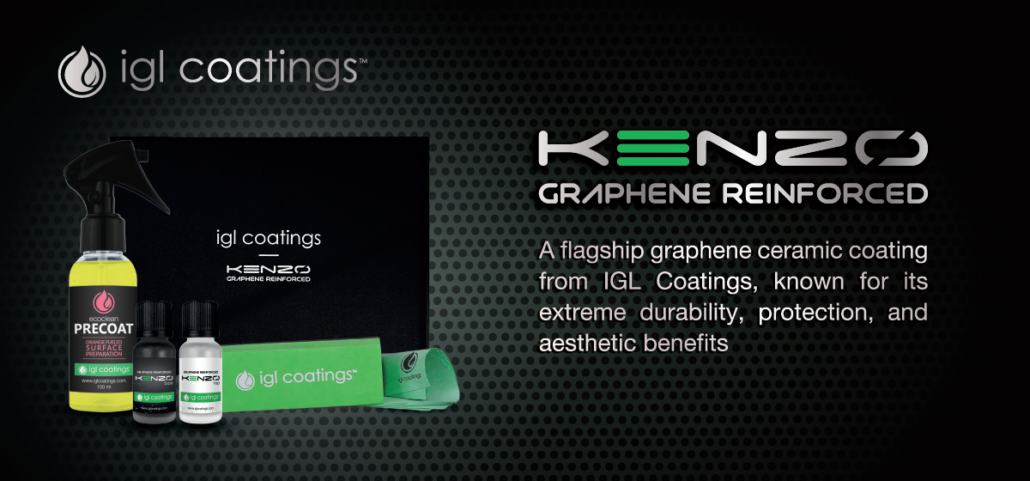
- Description: Ecocoat Kenzo is a flagship graphene ceramic ceramic coating from IGL Coatings, known for its extreme durability, protection, and aesthetic benefits. The formulation is REACH-compliant with 100% active ingredients, making it highly efficient and long-lasting.
- Durability: Up to 5 years of protection, making it one of the longest-lasting coatings in IGL’s product line.
- Hardness: 10H on the pencil scale, providing superior scratch resistance.
- Hydrophobicity: Features a water contact angle of around 120°, making it highly water-repellent, which helps in keeping the surface cleaner.
- Other Features: Enhanced gloss and clarity, self-cleaning properties, and reduced micro-marring. The graphene reinforcement increases protection against environmental factors like UV rays, water spots, and chemical exposure.
- Application: It requires a dual-layer system and is best suited for professional installers.
- Client Reviews
Client Testimonial of Ecocoat Kenzo
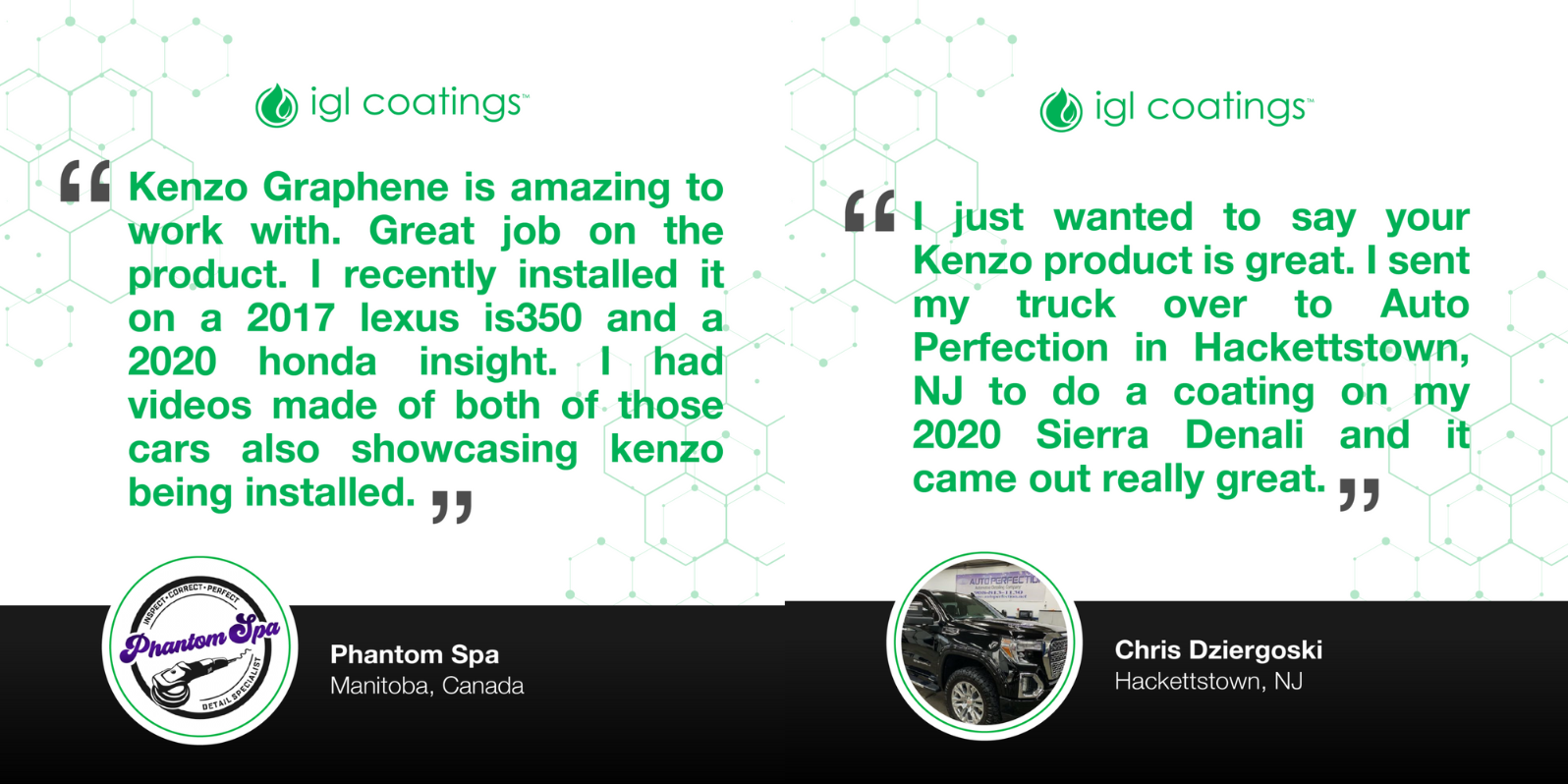
2. Ecocoat EZ
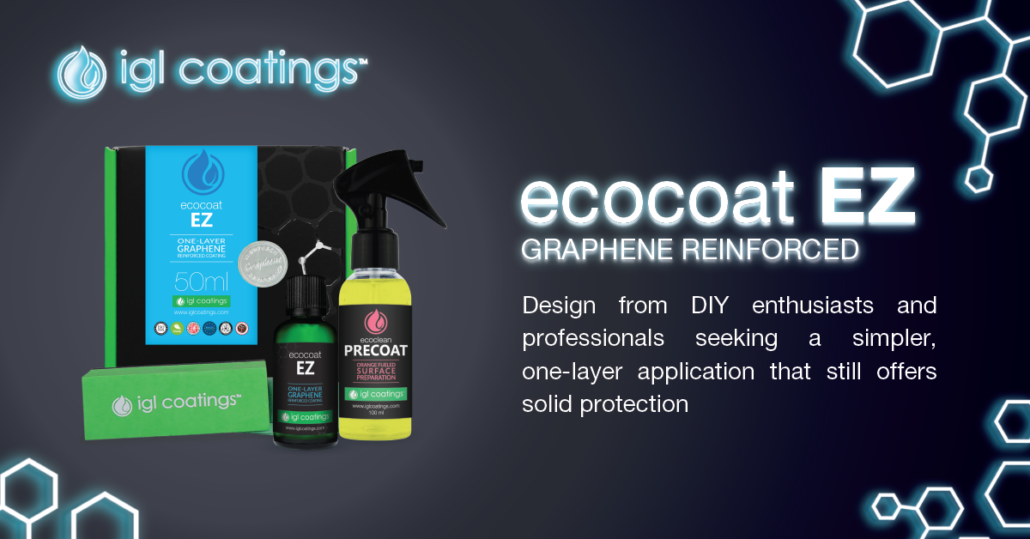
- Description: Ecocoat EZ is designed for DIY enthusiasts and professionals seeking a simpler, one-layer application that still offers solid protection. This product is also graphene ceramic, making it more durable and effective than conventional ceramic coatings.
- Durability: Provides up to 12 months of protection, making it more suitable for those seeking short-term durability.
- Hardness: 8H on the pencil scale, offering strong resistance to scratches and physical wear.
- Hydrophobicity: It has a water contact angle of around 105°, providing a high level of water repellency and ease of cleaning.
- Other Features: EZ is known for its ease of application, single-layer system, and its versatility across multiple surfaces, including paint, glass, and wheels. It also has resistance to water spots, chemicals, and weathering.
- Application: This product is optimized for ease of use, making it an excellent choice for beginners or time-conscious detailers.
- Client Review
Client Testimonial of Ecocoat EZ
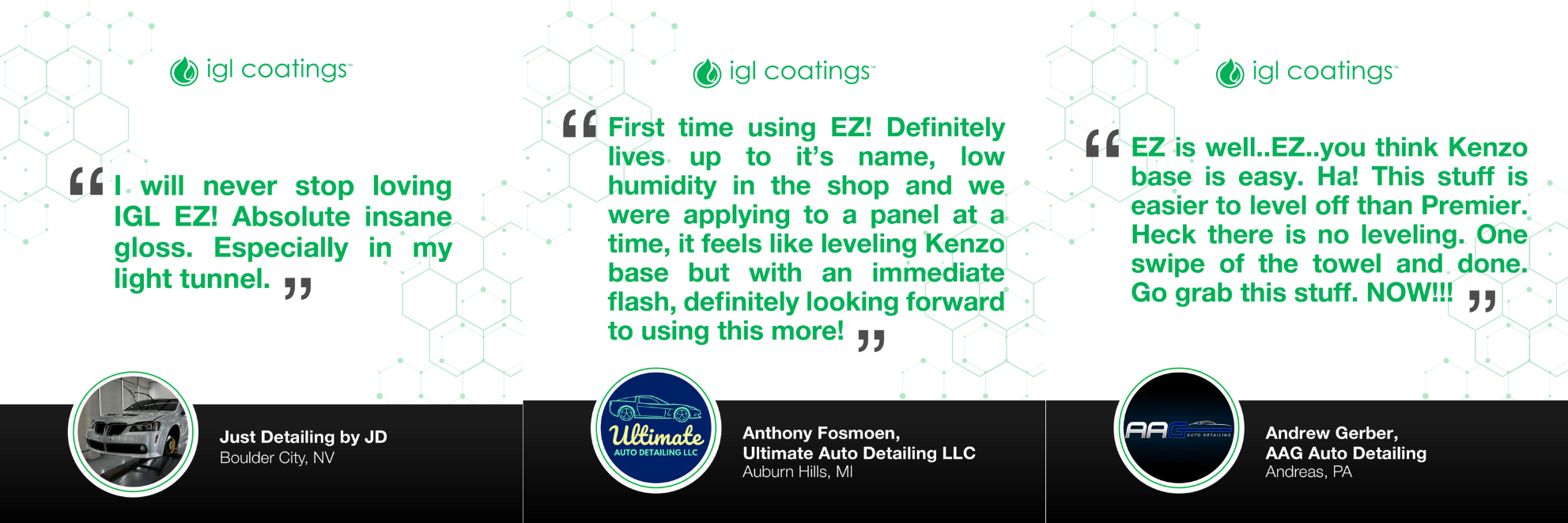
3. Ecocoat Quartz+
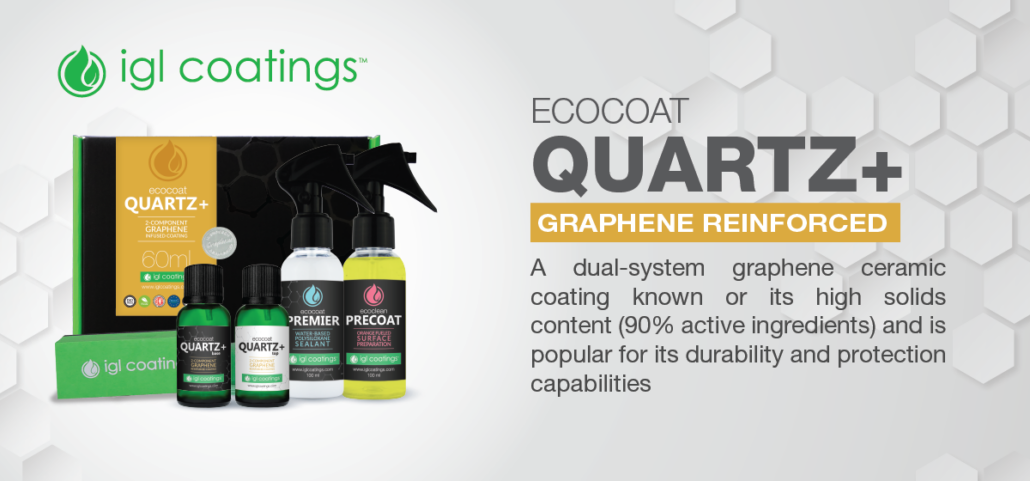
- Description: Ecocoat Quartz+ is a dual-system graphene ceramic ceramic coating known for its high solids content (90% active ingredients) and is popular for its durability and protection capabilities.
- Durability: Lasts up to 4 years, making it an excellent long-term solution for those seeking a balance between Ecocoat Kenzo’s high-end performance and Ecocoat EZ’s ease of use.
- Hardness: 9H on the pencil scale, ensuring strong resistance to physical damage.
- Hydrophobicity: With a water contact angle surpassing 110°, it provides excellent water repellency and remains effective for extended periods.
- Other Features: Quartz+ offers enhanced clarity, superior gloss, improved slip angle for easier cleaning, and increased resistance to water spots and chemicals. The addition of graphene nanoplatelets significantly improves its mechanical properties and environmental resistance.
- Application: This product uses a two-layer system (base and top coats) to achieve maximum protection and longevity.
Summary and Recommendations
- Ecocoat Kenzo is the best choice for those seeking the ultimate in durability, gloss, and protection, particularly for high-end vehicles and long-term use.
- Ecocoat EZ is ideal for beginners or those looking for a simpler, faster application with reliable protection, albeit for a shorter duration.
- Ecocoat Quartz+ offers a balanced option for those who want extended durability and enhanced hydrophobic properties without the complexity of professional-level applications like Kenzo.
Your choice depends on your specific needs, whether it’s long-term protection, ease of application, or high performance.
About IGL Coatings
IGL Coatings has rapidly ascended to become a leading name in the automotive detailing industry in the US since our establishment in 2015. Originating from Malaysia, we have achieved international acclaim for our innovative surface protection solutions, which emphasize sustainability and advanced technology. IGL Coatings is renowned for our commitment to research and development, creating high-performance coatings that offer exceptional durability and enhanced aesthetics.
Our global reach extends to over 50 countries, where we support a network of more than 5,000 micro-entrepreneurs. This global presence is bolstered by strategic partnerships and a robust distribution network, which has facilitated our recognition as the highest growth manufacturer in Malaysia and one of the top 500 high-growth companies in the Asia Pacific.
IGL Coatings: Industry Recognition
Our dedication to quality and innovation has also been recognized through various awards, including the prestigious SEMA Media Award and the International Detailing Association’s Detail Supplier of the Year award.
These accolades reflect our commitment to excellence and our role as a leader in the industry. Our continuous innovation and adherence to high standards have made us a trusted name among professionals and enthusiasts worldwide.
Follow us on social media:
Facebook | LinkedIn | Instagram | Twitter | YouTube | TikTok


